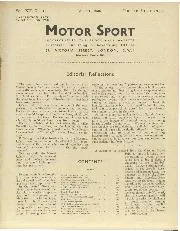
CONTENTS, August 1936
CONTENTS British Cars do well at Spa 371 Continental Notes and News • 374 The ILS.A. promotes a Road Race 376 Ford V. 8 wins Leinstcr Trophy Race 378 Value…
TO DEFEAT WHEELSPIN
ALMOST every car has in its back axle a differential, which permits of inter-rear-wheel movement when cornering. Certain French small sports-cars were notably possessed of differential-less axles, perhaps because their designers were never given Mecca= sets in their youth with which to model the differential—which is about the only way to understand how it functions. The snag about the differential of ordinary construction is that it allows all the drive to pass to the free wheel when one rear wheel is locked or impeded. On a trials hill this gives rise to excessive spin. Consequently, certain trials drivers have locked solid their car’s differentials, by bolting them up, or, more crudely, by pouring molten lead into the assembly. S. H. Allard used to lock his differential on the original Allard-Special as required, by a system of brakes formed of Morris clutch plates brought into operation by an outside hand-lever. This had an interesting sequel, when, almost stopping on a bad hill, Allard seized the hand-brake, whereupon several observant people protested that he had locked up his differential, UL what was a non-solid-axle trial. Actually, at the time his device was not in use, and we believe he abandoned it
because of the impossibility of avoiding sheared axle-keys when thus locking the assembly. Now that competition tyres are banned In trials, wheel spill is a major problem and in certain quarters it is expected that most well known drivers will use locked axles where these are not banned
by the regulations. Unfoitunately, a solid axle results in excessive tyre wear and sometimes adversely affects cornering. Moreover, it is so often barred by the regulations, except where used as standard by a manufacturer, as in the case of the Frazer-Nash. A differential which seems likely to defeat spin very effectively while still remaining a differential within the meaning of trials regulations is the Z17, which is used on the Mercedes-Benz, Auto-Union and E.R.A. racing-cars. This differential works on a cant and pawl. system and prevents excess spin of the wheel which is carrying no load. It thus prevents the drive from passing to that wheel which is running on more slippery ground than its fellow, or which is bouncing clear of the ground. On the other hand, it still merits description as a differential, because it allows a certain degree of inter
movement, when cornering. In the ZF units used by E.R.A. this movement is limited to 15 per cent. The ZF controlled differential is made by Zahnra.dfabrik Friedrichshafen of Lake Constance, Germany. It should be investigated by all serious trials competitors and is handled in this country by H. Louis Lungmuss, of 5, Holland Road, Aston, Birmingham.
Another controlled differential is being made by L. M. Ballamy. Known as the L.M.B., this works on a piston system, whereby oil controls the differential action, the axle being locked by pistons endeavouring to compress oil within small radial cylinders and released as the oil escapes via ports in the pistons. It would appear that with the L.M.B. system there will be some danger of axle keys shearing, on account of the intermittent locking and unlocking of the axle shafts, or fluctuating loading on the keys. In the case of the 7.1` unit there is special provision for the drive to take up with the minimum amount of movement, while with this differential the drive ceases to that wheel which attempts to spin, whereas in the L.M.B. the axle locks up and both wheel g take the drive.